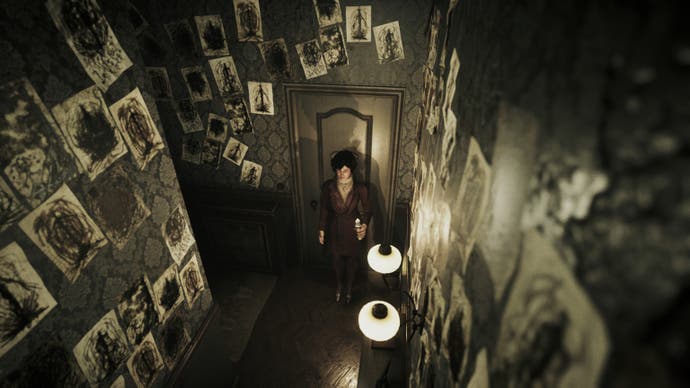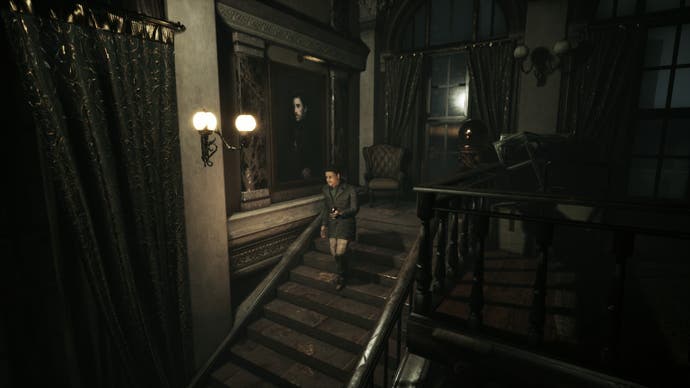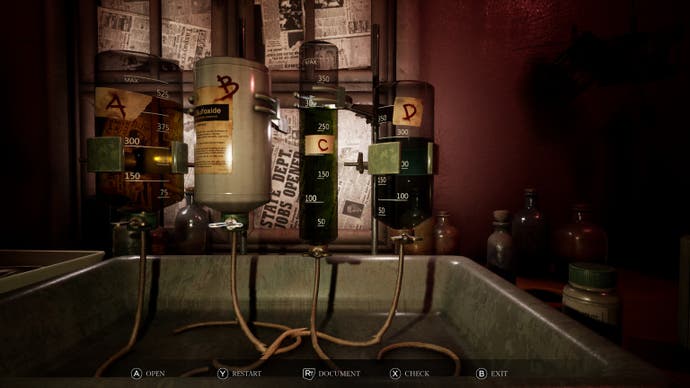Song of Horror is a quietly inventive homage to survival horror's glory days
Not so Silent Hill.
What does safety sound like in a game? We spend a lot of time as players thrilling over compositions and effects that get the adrenaline flowing - spectral piano, frantic violins, ambient mitherings that might, if you're very lucky, just be a broken aircon - but what about the compositions and effects that soothe and reassure? The Resident Evil series is full of them: bundle together every last Save Room melody and you've got a half-decent yoga playlist, though I'd probably chuck in some Okami or whatever to lift the mood. Gears of War has that satisfied guitar purr when you've winkled out every last Locust. The Sunless games have their port themes, wafted to you from off-screen like smoke on the breeze - music indeed to the captain coasting home on their last few lumps of coal.
And what of Song of Horror, Protocol's absorbing homage to the Silent Hills and Alone in the Darks of yesteryear? In Song of Horror, safety is a soft tap, right on the edge of hearing, like somebody very carefully setting down a glass. All being well, you'll hear it after a few seconds when you put your ear to a door. The tap, which surely represents a lot of calculation on the part of the audio designer, is a vital cue in a game where silence has many textures. Sometimes, silence sounds like silence. And sometimes, it sounds... bonier. Squelchier. As though you had your ear pressed against a misbehaving stomach. In which case, opening that door is... unwise. Better to switch to your map screen, work out another route, and hope like hell that when next you put your ear to a door, the tap is all you can hear.

Now three of five episodes in, Song of Horror is a third-person, combat-free spookfest with automatic camera perspectives and a refreshing taste for the procedural. Players rove dark, abandoned buildings solving puzzles while evading various ambient threats known collectively as the Presence. Snooping at doors is crucial because said threats - which kill off characters forever, should you fail the associated QTEs - are ever-changing, assuming different forms at different times in different places, based on a mixture of loose scripting and monitoring of player behaviour. You're hurrying down some stairs, brandishing a candlestick like the shotgun you sorely wish you had, when oily black handprints blossom all over the walls. You're inspecting a desk when something bandaged and breathy pops up on the other side of it, snuffling for your blood.
Who exactly you're playing is one of the more important variables, though not, I think, as decisive as it should be. There are four character stats, Serenity, Strength, Speed and Stealth, which lightly skew the odds ahead - the first two determine how difficult it is beat those QTEs, while Stealth appears to set the basic probability of an encounter triggering in any given room. More substantially, choice of character alters the mood of the space you're in, as each character describes each interactive object a different way - a quietly surprising flourish that hasn't been developed to the full. Last year I wrote about how it feels to return to Resident Evil 2's police station in different games, the phantom-limb disquiet of finding familiar objects altered or removed, old rooms expanded or sewn shut. Song of Horror is also about the relentless return of a space, a space that both has a mind of its own and is gently (re)characterised by the poor souls doomed to roam it.

Each episode stars a different building and gives you three or four characters to play with, some (providing they survive) carried over between episodes. Lose a character and you must try again with the next, retracing their steps to gather up the items they were carrying and the bloody, bitten-off threads of whatever riddle they were unravelling. The first is set in the gloomy mansion home of a novelist, Sebastian Husher, whose disappearance owes something to the music box you can hear, warbling away behind the skirting boards. You might begin here as Sophie van Denend, an art dealer searching for her ex-husband. Sophie comes armed with scented candles, useful for creating a calm atmosphere that minimises the chances of an icky manifestation. She can also name and date the house's ominous paintings, some of which play a role in puzzles.
The robust and heavy-drinking Alexander Laskin, meanwhile, is one of the Husher family's housekeepers. He lacks Sophie's book smarts, but he understands each painting's history within the house, remembering where they used to hang and how it felt to work around them. Security technician Alina Ramos is a stranger to both the Hushers and fine art, but she does know how to deactivate a door alarm, and has plenty to say about the house's former occupants based on her own family background.
In changing characters the character of the building changes, which makes killing people off essential to appreciation of Song of Horror, as morbid as that may seem. Sadly, the script isn't that hot, and the voice-acting is B-movie to the hilt (there's an English character who sounds like he's doing a drunken impression of Eddie Izzard's drunken impression of James Mason), but the game gets enough out of its relatively unusual ensemble premise to keep you guessing. You only need to keep one particular character alive between episodes to progress the story - a run-of-the-mill Lovecraftian race to determine the origins of a cursed artefact - so feel free to let the odd person go for the sake of variety. Characters don't quite vanish when the Presence snaffles them, mind you. There's never a body, but the victim may linger on in other ways.

Song of Horror's obvious strength is its architecture and interior design, which spurns the genre's beloved impossible geometry in favour of good old-fashioned sense-of-place. The Husher estate is smaller, but every bit as intricate as Resident Evil's legendary Umbrella mansion, and rather less silly of structure. It's divided between the housekeepers' quarters, a winding basement, a small library, an office, bedrooms, creepy playrooms - there's a dollshouse that uncannily resembles the one you're in - and a mouldering attic. Episode 2 takes you to an antique shop with an eerie fairground attraction in the lobby, backing out onto apartments where the owner and his daughter live. The quality of the interior design is heightened by solid camera composition: think views from a ceiling corner, as though your fly on the wall were the Babadook, and head-on tracking shots that deny you a clear look at what awaits you down the hall. A little disappointingly, the university in episode 3 consists of three, separately loading departments rather than a persistent space, but it does contain one terrific puzzle that troubles the border between image and reality.
The puzzles are gentle, quite varied, and mostly intuitive: good and bad, they exist to keep you shuttling back and forth between the far corners of the layout, in the face of the Presence's efforts to box you in or scare you off. Many are just about combining objects (which can be rotated in the pause screen to reveal clues) in mildly eccentric ways. Some are numbers-based, others see you matching telltale details in documents to things like library signs. There's perhaps one puzzle that is just plain annoying, a meandering riddle left for you by a smug professor (as with dialogue lines like "not another fetchquest?!" having characters call a puzzle irritating in the game does not actually lessen the irritation). The puzzles are best when they symbolise some element of the story being played out, and when they work with or against the structure that contain them. The dollhouse, inevitably, is more than it seems.

Song of Horror's greatest weakness is, alas, probably the Presence itself. It's oppressive indeed when out of view, because you're always wondering when it will show up. You learn to time its appearances, and there's nothing like the dread when you're close to completing an episode but overdue a reckoning. The Presence's actual manifestations aren't that startling, however - think skellingtons and tentacles - and the problem with this being a procedural affair is that you quickly start to think of the scares as mechanical moving parts. The QTEs are as divisive as QTEs tend to be. I'd rather not spoil either the specific dangers or how you escape from them, but suffice to say you can expect button-bashing and rhythm-matching. The latter bits led to the game being all but unplayable over the winter, thanks to a performance bug that made it impossible to keep time; thankfully, this seems to have been fixed.
Song of Horror's spooks aren't quite worthy of the build-up, then, but isn't that true of every monster, once it has shambled into the spotlight? The quality of the game's location design, together with the not-quite-realised potential of its ensemble premise, make it something more than a Greatest Hits. It's like a collection of planetary fragments that has mustered enough gravity to form a brand new planet. I'm looking forward to episode 4, out at the end of the month, which takes place in a ruined medieval abbey. Who knows what lurks behind those ancient doors? Better listen extra-carefully for the tap. Mind you, fostering a sense of security is one of the more devious tools in the horror designer's arsenal. Perhaps where this game's safer flavours of silence are concerned, the other shoe is still waiting to drop.
Song of Horror is out now on PC, and coming to PS4 and Xbox One this year.

